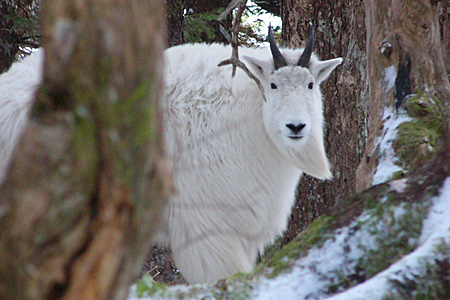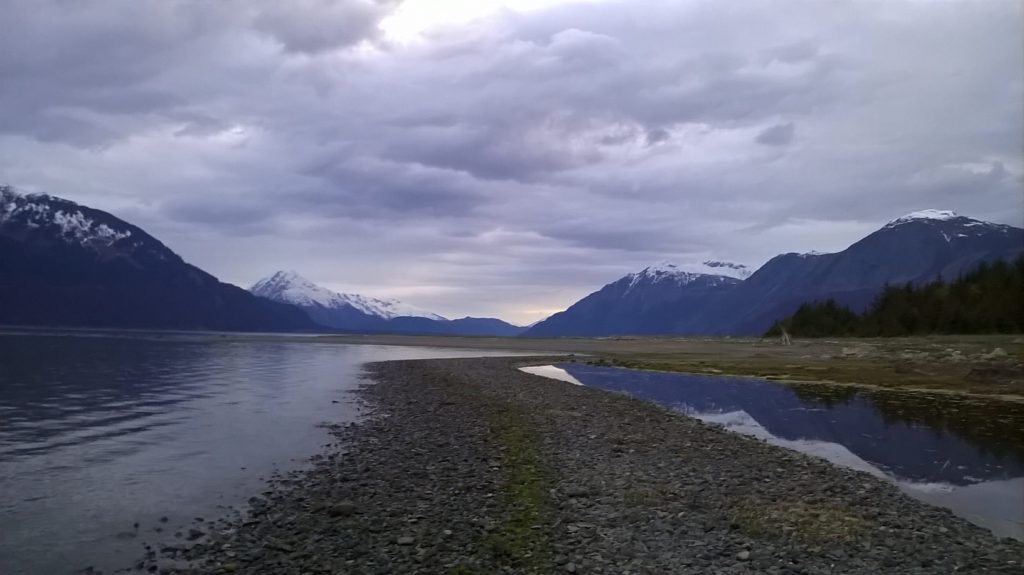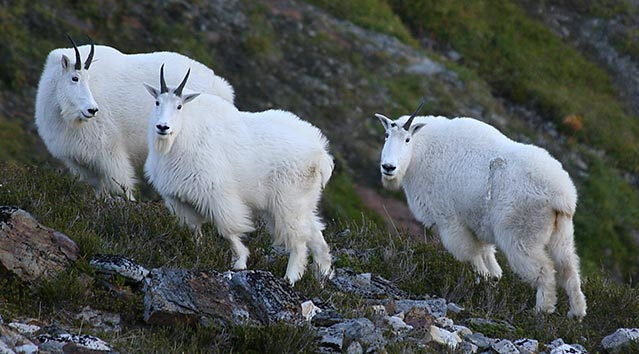
Biologists are researching Chilkat Valley mountain goat habitat. (Photo credit: Alaska Department of Fish and Game)
Over recent weeks, a Haines committee has met to make recommendations on whether to open new areas for helicopter skiing. The heliski map committee’s deadline is Nov. 30. But another committee – one tasked with considering local wildlife populations – wants the heliski map process to slow down. They say the borough should wait to make changes to the map until research on area mountain goats and bear dens is complete.
“What are mountain goats in the Haines area doing? Are they wintering up high or are they wintering down low?” Alaska Department of Fish and Game biologist Kevin White posed that question as he presented initial findings last April.
White has spent much of the past six years tracking mountain goats in the Upper Lynn Canal. The goal is to map goats’ habitat. The incentive for this research has a lot to do with the heliskiing industry. If biologists know where the important mountain goat habitat is located, they can try to steer helicopters clear of those areas. There is already research that shows goats are sensitive to helicopter noise.
“This is an Upper Lynn Canal Fish and Game advisory committee,” said committee chairman Tim McDonough at a Wednesday meeting. “And it seems that the purpose is to keep in mind we’re looking to have healthy populations of fish and game. And that should be our interest and what drives us.”
That’s why McDonough, and the rest of the eight committee members present, unanimously supported a letter to the borough.
“The expansion of the heliski map has the potential to negatively impact wildlife,” committee member Kip Kermoian read from the letter. “Until data can be quantified and evaluated it will be unclear about what the potential impacts can be.”
It goes on to ask the borough suspend decisions on the heliski map until biologists are ready to present preliminary data on mountain goats and bears. Fish and Game is working on a bear den study using aerial surveys. One of the motivations behind that study is also to gather better information for heliski management.
Here’s the problem with the advisory committee’s request: the borough has already set a timeline for heliski map changes. The committee recommendations are due at the end of this month. Then, the borough manager is due to make a recommendation to the assembly in December. The assembly has the final say.
McDonough asked, why can’t the map amendments wait?
“The push to get this done, is it imperative it gets done within the next month?” he asked.
“The timeline was kind of a compromise,” said heliski map committee chairman Ron Jackson, who also sits on the borough assembly.
Jackson says essentially, the borough is trying to make up for a mistake in code that left timely map amendment requests in limbo for much of the past year.
In May, two heliski operators submitted map amendment proposals. But timeline regulations in code made it difficult for the assembly to decide on those requests. So, in September, the assembly revised the code.
“What we wound up with was this kind of dangling situation where two operators had submitted changes but yet the code was unworkable,” Jackson said. “So we made some changes to make it workable and in the process figured we had to go ahead and honor those requests this year.”
The assembly approved a special heliski map committee to convene this fall. That way, the two company’s requests could still be heard and decided on in 2016.
But in the Fish and Game advisory committee’s view, the interests of the heliski businesses shouldn’t take precedence over the valley’s wildlife.
“One year’s worth of additional clients is potentially not worth the impacts to wildlife,” said Kermoian. “We don’t know what those may be.”
Fish and Game area biologist Carl Koch was on the phone. His department is working with the map committee, providing what information they can. But Koch says he would prefer the borough wait until their research is solidified before opening new areas to heliskiing. He said of the locations the map committee is reviewing, there are a few that seem OK. But he said “more often than not there’s concern.”
Koch said the goat and bear researchers will have preliminary information ready in 2017, but he’s not certain when.
The map committee’s next meeting is Monday, Nov. 21.








